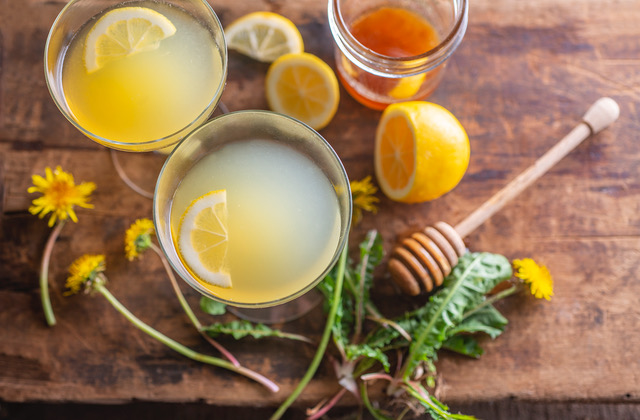If your neighbors are wondering why you have so many dandelions growing in your yard just let them know you are saving them to make dandelion honey. Whether you are headed out camping this weekend or just kicking your feet up in your own backyard, the Bees Knees Cocktail with Dandelion Honey from the recently released book Camp Cocktails: Easy, Fun and Delicious Drinks for the Great Outdoors by Emily Vikre of @vikredistillery will start it out just right!
Dandelion Honey
Makes ¾ cup (240 g)
The warm, complex sweetness of wildflower honey is the perfect foil to the bright dandelion flower aroma. And making an infusion is as simple as stirring the two ingredients together. Not only is this honey a delicious cocktail ingredient, but it is also tasty in tea.
1 cup (about 100 g) dandelion flowers
¾ cup (255 g) honey
Check the flowers to make sure you remove any little insects or other passengers, then put the flowers in a jar. Cover the flowers with the honey, gently pressing the flowers into the honey to make sure there aren’t any large air bubbles. Seal the jar and allow to steep for 2 weeks. (You can steep it even longer for a more pronounced flavor.) If you wish to strain the flowers out of the honey, gently heat the honey to make it more liquid, then strain it through a fine-mesh strainer. Store your honey in a sealed jar at room temperature. Honey keeps forever. (Literally. Several years ago it’s said that archaeologists found jars of honey in a tomb from ancient Egypt and it was still good for eating.) To make honey syrup: Combine 2 parts dandelion-infused honey with 1 part water and stir until dissolved.
Cocktail
Make a Bees Knees by adding 2 ounces (60 ml) gin, ¾ ounce (23 ml) fresh lemon juice, and ¾ ounce (23 ml) dandelion-infused honey syrup to an ice-filled shaker. Shake until chilled, then strain into a coupe glass.

Dandelions
Is there any flower more friendly than a dandelion? Sure, they are weeds, but their powerful will to take root and grow in any lawn and through any crack in the road feels to me like a testament to the power of optimism. The dandelion was actually brought to North America by European settlers to grow for food, wine, and medicine. The flower, leaves, and root are all edible. And because it is non-native and definitively a weed, you don’t have to worry about over harvesting as you do with native wild plants.
I remember making dandelion-flower fritters in fifth grade. The flavor was fine, but I couldn’t enjoy the thick, feathery texture of the layered flower petals. I much prefer to use dandelion flowers for infusions, in which they give a surprisingly aromatic flavor that reminds me of lemon balm.
© 2020 Quarto Publishing Group USA Inc.
Text and Photography © 2020 Emily Vikre
First Published in 2020 by The Harvard Common Press, an imprint of The Quarto Group




